LEARNING TO BOOGIE IN WILLIAMSBURG (1857)
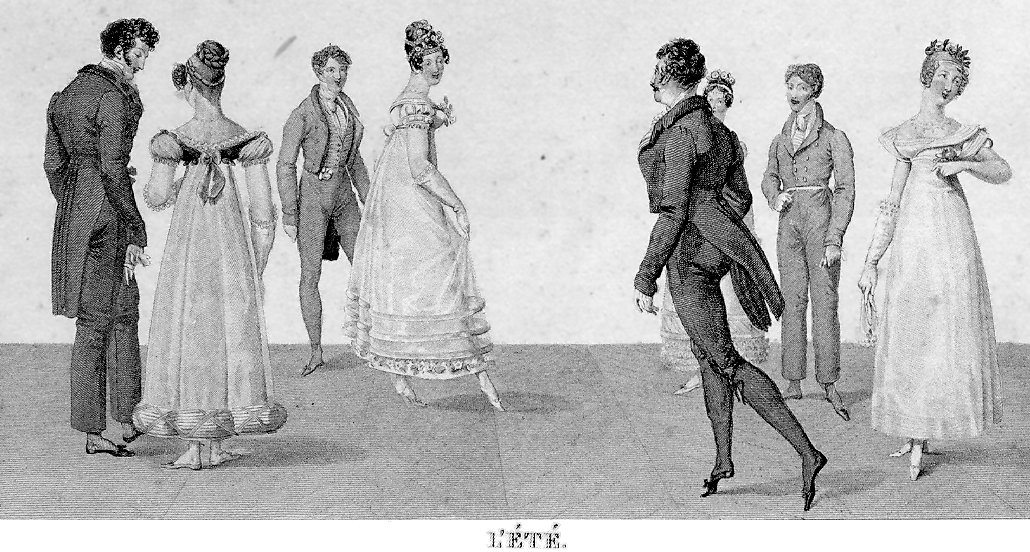
Brownstone Detectives investigates the history of our clients’ homes.
The story you are about to read was composed from research conducted in the course of one of those investigations.
Do you know the history of YOUR house?
********************************************************************************************************************************
People loved to dance back in the 1800s.
Their dancing was mostly formal, almost mimicking a prepared act, but it took place in social settings allowing participants to display a good amount of that godly grace their lives often lacked. And people danced not just to exercise, but to socialize, to entertain themselves, and to hear about the latest news from their old and new friends.
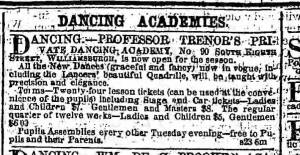
And everyone wanted to know the latest dances so that they were not embarrassed in such polite company, or so that they could – at the very least – discuss these dances intelligibly.
THE 19TH CENTURY’S DISCO
In 1857, the Lancers’ Quadrille was all the rage – and by “all the rage,” I mean “ALL THE RAGE.” It seemed that every dance school was teaching it, every tongue was wagging about it, and every newspaper dance academy ad offered its instruction.
The Lancers’ Quadrille was a dance performed by four couples – it was a precursor of sorts to the square-dance, albeit a more refined square dance where everyone dressed supper classy and pretended to be nobility.
SQUARE DANCIN’ IN BILLYBURG (W/PROF. TRENOR)
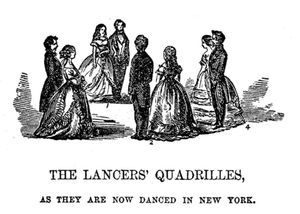 In Williamsburgh, there existed Professor Trenor’s Private Dancing Academy, at No. 90 South Eighth Street near the East River. It was likely a modest if large wood frame house of one or two stories, with a great open room – heated in winter by a potbelly stove – on the main floor for dancing.
In Williamsburgh, there existed Professor Trenor’s Private Dancing Academy, at No. 90 South Eighth Street near the East River. It was likely a modest if large wood frame house of one or two stories, with a great open room – heated in winter by a potbelly stove – on the main floor for dancing.
The Professor was likely, himself, an older gentleman who had at one time been quite a gay blade making the rounds of what high society existed at that time in Brooklyn or Manhattan, and who was now teaching dance to younger folks to make ends meet in his declining years.
Trenor announced, through his ads in 1857, that “PROFESSOR TRENOR’S PRIVATE DANCING ACADEMY” was “now open for the season.”
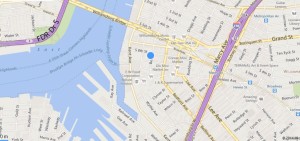
He advertised “(a)ll the new dances (graceful and fancy) now in vogue; including the Lancers’ beautiful Quadrille,” which, he emphasized, would “be taught with precision and elegance.”
His lessons, though, did not come free.
PAYING TO DANCE
“Terms – Twenty-four lesson tickets (can be used at the convenience of the pupils) including Stage and Car tickets-Ladies and Children $7. Gentlemen and Masters $8.”
And to increase the interest in his academy, he offered every Tuesday night as a sort of “bring your parents and they get in free” night. It must have gotten him the patronage of not a few unwieldy matronly types who, unfortunately for their children, brought embarrassment onto the family.
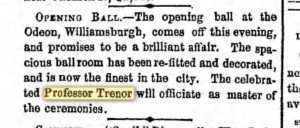
Another of his ventures at attracting those otherwise not inclined to participate in his academy, was to persuade hopeful dance aspirants from near and far, by offering to all pupils “residing at a distance from the Academy” the luxury of “Stage and Car Tickets FREE.”
Trenor advertised his instruction September of 1857 through January of 1858, and then he took a break from teaching until the following season began again in September.
THE DOWNFALL OF PROF. TRENOR
The following season, however, Prof. Trenor’s Dance Academy would become the subject of a take-over (hostile or not) of a Mr. A. A. Marcellus, who respectfully announced that “he has been solicited to re-establish a first class school in this part of the city, for the instruction of boys.”
Trenor did reprise his role at the opening of the season at the Odeon in Williamsburgh, however, where he officiated as master of ceremonies.
It would be his last known public appearance.
That year, as his former building filled with the boys of parents desirous of their getting an “English, Classical and Commercial Education,” Prof. Trenor faded from the scene. No longer mentioned in the papers, and he slipped quietly – and one hopes, comfortably – into the ages.
———————————————————————————————————————–
 Brownstone Detectives is an historic property research agency. Our mission is to document and save the histories of our clients’ homes. From our research, we produce our celebrated House History Books and House History Reports. Contact us today to begin discovering the history of your home.
Brownstone Detectives is an historic property research agency. Our mission is to document and save the histories of our clients’ homes. From our research, we produce our celebrated House History Books and House History Reports. Contact us today to begin discovering the history of your home.